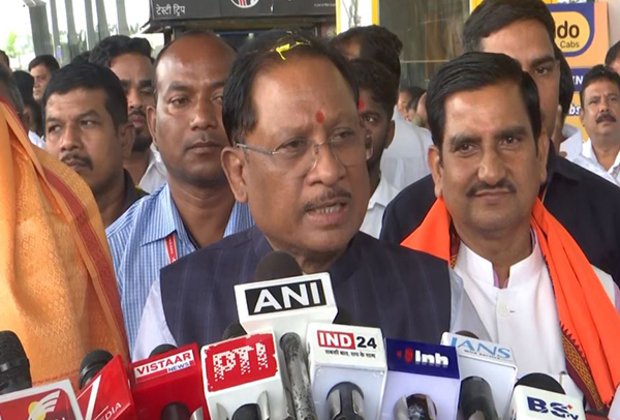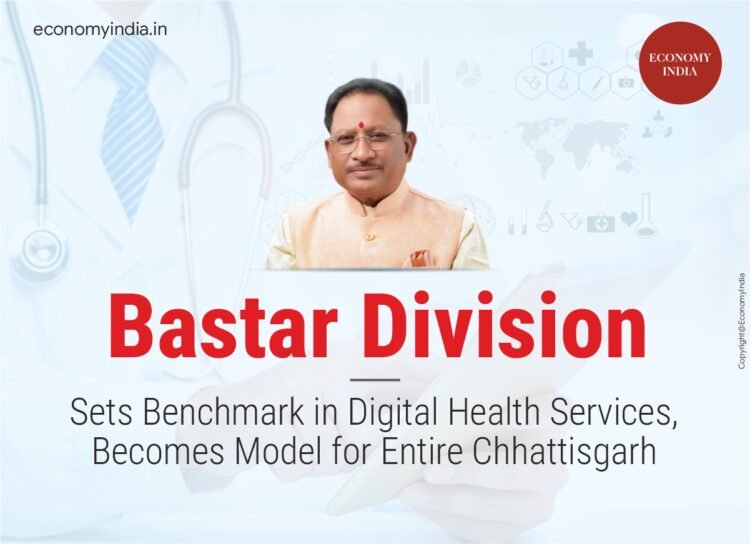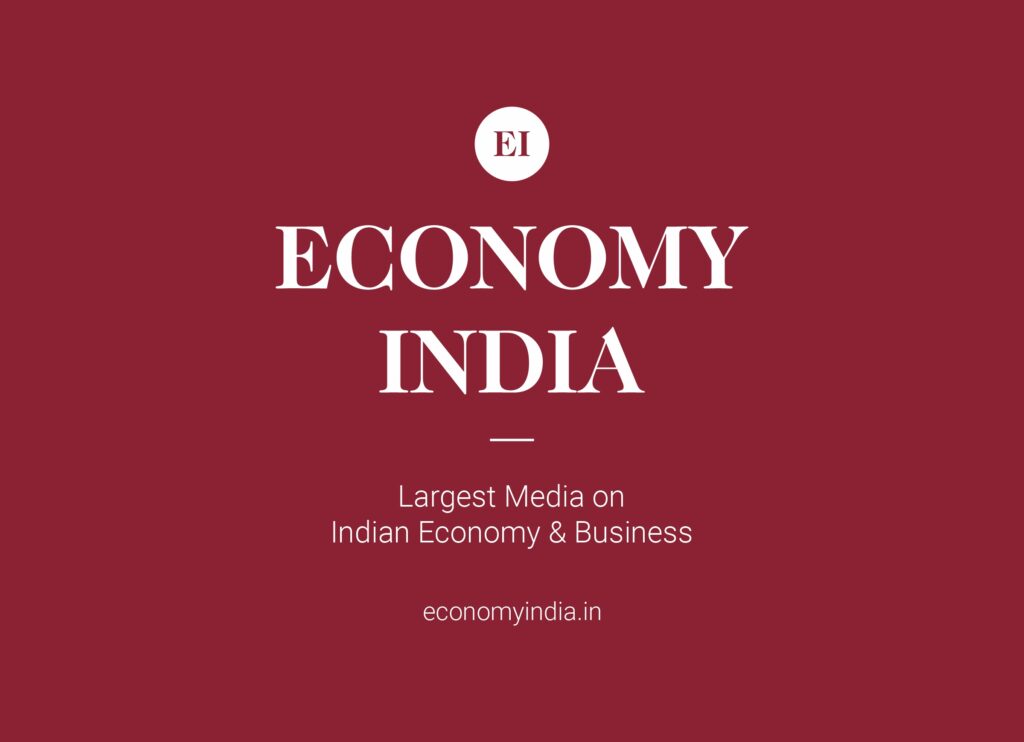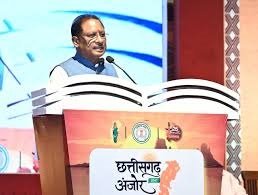“Bastar’s OPD registration surge and extensive hospital coverage position it as a leader in Chhattisgarh’s digital healthcare revolution”
Raipur, August 10 (Economy India) – In a transformative leap for public health delivery, Bastar division in Chhattisgarh has emerged as a statewide model for digital healthcare integration, setting a precedent that officials hope to replicate across all districts. Through the combined deployment of Next-Gen E-Hospital, Ayushman Bharat Digital Mission (ABDM), and Ayushman Bharat Pradhan Mantri Jan Arogya Yojana (AB-PMJAY), the region is redefining how technology can be leveraged to deliver efficient, transparent, and patient-friendly services.Vishnudev Sai health reforms
The initiative, spearheaded under the leadership of Chief Minister Vishnudev Sai and guided by Health Minister Shyam Bihari Jaiswal, has not only modernised hospital operations but has also significantly improved patient experience.

A Vision for Technology-Driven Healthcare
Bastar’s journey towards becoming a digital health pioneer began as part of the state’s larger vision to ensure that every citizen – whether in urban centres or remote tribal villages – can access quality healthcare without facing bureaucratic hurdles or long waiting times.
Chief Minister Vishnudev Sai has made healthcare expansion in Bastar a top priority, while Health Minister Shyam Bihari Jaiswal has ensured that technological adoption is not limited to urban hospitals but extends to rural and community health centres.
The result is a comprehensive digital health ecosystem that allows for:
- Real-time patient data recording
- Online OPD registration through ABHA-linked accounts
- Digital prescriptions and lab reports
- Transparent record-keeping and reduced manual paperwork

Where the Transformation is Happening
The Next-Gen E-Hospital system is now functional in:
- 6 district hospitals
- 2 civil hospitals
- 41 community health centres across Bastar division
This network covers almost the entire region, ensuring that both secondary and primary healthcare facilities are part of the digital revolution.
Using the system, hospital staff can now manage patient registrations, consultations, diagnostic tests, pharmacy distribution, and medical history on a single unified platform.
Data Speaks: High Digital Adoption Rates
The numbers from the last three months demonstrate how rapidly the people of Bastar have embraced this new system:
- District Hospital Bastar
- Total OPD registrations (May–July 2025): 60,045
- ABHA-linked registrations: 32,379 (53% digital adoption rate)
- District Hospital Dantewada
- Total OPD registrations: 33,895
- ABHA-linked registrations: 13,729 (40% digital adoption rate)
This means over half of all OPD patients in some districts are now registering digitally, cutting down on queue times and paperwork.
How ABHA is Changing the Patient Experience
The Ayushman Bharat Health Account (ABHA) system has become a game-changer. By creating a unique digital health ID for each patient, it enables:
- Scan & Share OPD registration: No need to manually fill out forms
- Access to digital health records anywhere in India: Patients can carry their medical history virtually
- Continuity of care: Doctors can review past prescriptions and diagnostic reports instantly
- Reduced errors: Elimination of misplaced paper records
With ABHA kiosks now set up inside hospital premises, creating an account is quick and simple – a major factor in driving adoption.
Leadership Voices
Chief Minister Vishnudev Sai emphasised the broader impact of the initiative:
“The successful implementation of Next-Gen E-Hospital and ABDM in Bastar has given healthcare services new speed and direction. This model will soon be implemented across all districts to achieve our vision of a healthy and empowered Chhattisgarh.”
Health Minister Shyam Bihari Jaiswal highlighted the replicability of the model:
“This digital healthcare upgrade is proving immensely beneficial for Bastar and will soon serve as a standard for the entire state. The goal is to create a unified, transparent, and efficient healthcare network.”
Beyond Digitisation: Reaching Rural and Remote Areas
While the adoption of technology in urban and semi-urban areas is relatively straightforward, Bastar’s achievement is particularly significant because of its geography and demography.
- Large tribal population
- Remote villages with limited road connectivity
- Historically lower access to specialised healthcare
By bringing these areas into the digital health fold, the government is bridging a long-standing gap in public health delivery. Mobile health teams and outreach programmes are also being aligned with the digital records system so that even field consultations and village health camps are documented in the ABHA ecosystem.

Transparency and Efficiency Gains
According to hospital administrators, the benefits go beyond convenience for patients:
- Real-time data tracking allows for better resource allocation
- Inventory management for medicines is now digital, reducing stockouts
- Patient wait times have dropped due to faster registrations
- Data security ensures sensitive medical information is protected
Positive Impact on Governance
From a governance perspective, the digital shift is creating a data-driven healthcare system. This means policymakers can:
- Track disease patterns in real-time
- Plan targeted health interventions
- Allocate funds more effectively based on usage statistics
Future Roadmap
State health officials have confirmed that the Bastar model will be rolled out across all districts in a phased manner by mid-2026. Upcoming plans include:
- Linking telemedicine services directly to ABHA IDs
- Integrating private hospitals into the digital network
- Offering patient mobile apps for appointment booking and report downloads
Why Bastar’s Success Matters Nationally
Bastar’s experience aligns with the National Digital Health Mission’s goal of creating a single interoperable digital health network for India. If such a system can thrive in tribal-dominated, geographically challenging regions, it offers hope for nationwide adoption.
Healthcare experts believe that Bastar could be cited as a case study for how rural and semi-urban India can leapfrog into advanced healthcare systems without waiting for decades of incremental change.
Raipur, August 10 (Economy India) – In a transformative leap for public health delivery, Bastar division in Chhattisgarh has emerged as a statewide model for digital healthcare integration, setting a precedent that officials hope to replicate across all districts. Through the combined deployment of Next-Gen E-Hospital, Ayushman Bharat Digital Mission (ABDM), and Ayushman Bharat Pradhan Mantri Jan Arogya Yojana (AB-PMJAY), the region is redefining how technology can be leveraged to deliver efficient, transparent, and patient-friendly services.
The initiative, spearheaded under the leadership of Chief Minister Vishnudev Sai and guided by Health Minister Shyam Bihari Jaiswal, has not only modernised hospital operations but has also significantly improved patient experience.
A Vision for Technology-Driven Healthcare
Bastar’s journey towards becoming a digital health pioneer began as part of the state’s larger vision to ensure that every citizen – whether in urban centres or remote tribal villages – can access quality healthcare without facing bureaucratic hurdles or long waiting times.
Chief Minister Vishnudev Sai has made healthcare expansion in Bastar a top priority, while Health Minister Shyam Bihari Jaiswal has ensured that technological adoption is not limited to urban hospitals but extends to rural and community health centres.
The result is a comprehensive digital health ecosystem that allows for:
- Real-time patient data recording
- Online OPD registration through ABHA-linked accounts
- Digital prescriptions and lab reports
- Transparent record-keeping and reduced manual paperwork
Where the Transformation is Happening
The Next-Gen E-Hospital system is now functional in:
- 6 district hospitals
- 2 civil hospitals
- 41 community health centres across Bastar division
This network covers almost the entire region, ensuring that both secondary and primary healthcare facilities are part of the digital revolution.
Using the system, hospital staff can now manage patient registrations, consultations, diagnostic tests, pharmacy distribution, and medical history on a single unified platform.

Data Speaks: High Digital Adoption Rates
The numbers from the last three months demonstrate how rapidly the people of Bastar have embraced this new system:
- District Hospital Bastar
- Total OPD registrations (May–July 2025): 60,045
- ABHA-linked registrations: 32,379 (53% digital adoption rate)
- District Hospital Dantewada
- Total OPD registrations: 33,895
- ABHA-linked registrations: 13,729 (40% digital adoption rate)
This means over half of all OPD patients in some districts are now registering digitally, cutting down on queue times and paperwork.
How ABHA is Changing the Patient Experience
The Ayushman Bharat Health Account (ABHA) system has become a game-changer. By creating a unique digital health ID for each patient, it enables:
- Scan & Share OPD registration: No need to manually fill out forms
- Access to digital health records anywhere in India: Patients can carry their medical history virtually
- Continuity of care: Doctors can review past prescriptions and diagnostic reports instantly
- Reduced errors: Elimination of misplaced paper records
With ABHA kiosks now set up inside hospital premises, creating an account is quick and simple – a major factor in driving adoption.
Leadership Voices
Chief Minister Vishnudev Sai emphasised the broader impact of the initiative:
“The successful implementation of Next-Gen E-Hospital and ABDM in Bastar has given healthcare services new speed and direction. This model will soon be implemented across all districts to achieve our vision of a healthy and empowered Chhattisgarh.”
Health Minister Shyam Bihari Jaiswal highlighted the replicability of the model:
“This digital healthcare upgrade is proving immensely beneficial for Bastar and will soon serve as a standard for the entire state. The goal is to create a unified, transparent, and efficient healthcare network.”
Beyond Digitisation: Reaching Rural and Remote Areas
While the adoption of technology in urban and semi-urban areas is relatively straightforward, Bastar’s achievement is particularly significant because of its geography and demography.
- Large tribal population
- Remote villages with limited road connectivity
- Historically lower access to specialised healthcare
By bringing these areas into the digital health fold, the government is bridging a long-standing gap in public health delivery. Mobile health teams and outreach programmes are also being aligned with the digital records system so that even field consultations and village health camps are documented in the ABHA ecosystem.
Transparency and Efficiency Gains
According to hospital administrators, the benefits go beyond convenience for patients:
- Real-time data tracking allows for better resource allocation
- Inventory management for medicines is now digital, reducing stockouts
- Patient wait times have dropped due to faster registrations
- Data security ensures sensitive medical information is protected
Positive Impact on Governance
From a governance perspective, the digital shift is creating a data-driven healthcare system. This means policymakers can:
- Track disease patterns in real-time
- Plan targeted health interventions
- Allocate funds more effectively based on usage statistics
Future Roadmap
State health officials have confirmed that the Bastar model will be rolled out across all districts in a phased manner by mid-2026. Upcoming plans include:
- Linking telemedicine services directly to ABHA IDs
- Integrating private hospitals into the digital network
- Offering patient mobile apps for appointment booking and report downloads
Why Bastar’s Success Matters Nationally
Bastar’s experience aligns with the National Digital Health Mission’s goal of creating a single interoperable digital health network for India. If such a system can thrive in tribal-dominated, geographically challenging regions, it offers hope for nationwide adoption.
Healthcare experts believe that Bastar could be cited as a case study for how rural and semi-urban India can leapfrog into advanced healthcare systems without waiting for decades of incremental change.













